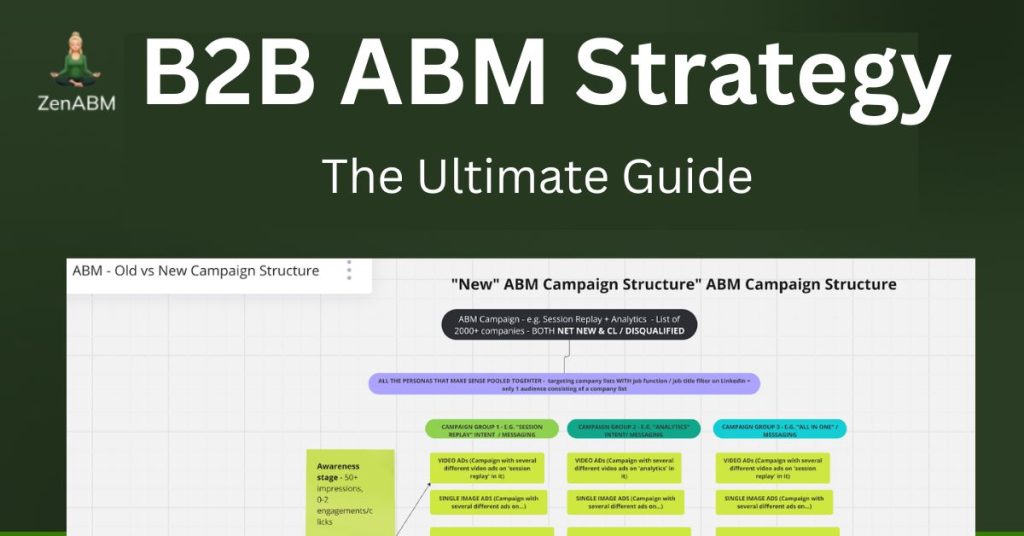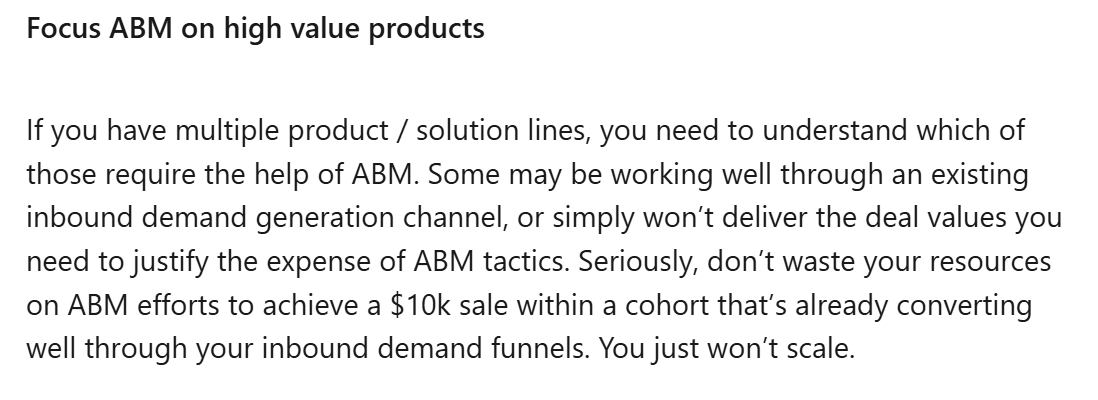ABM is about pursuing high-value accounts instead of casting a marketing net wide and hoping to catch MQLs/SQLs that your sales team always calls ‘not warmed up enough’ anyway.
This strategy makes even more sense for B2B, where the ACVs are high.
And in this article, with a real case study, I’ll show you how you can design your B2B ABM strategy that actually works (plus, where ZenABM has a role).
Be with me…
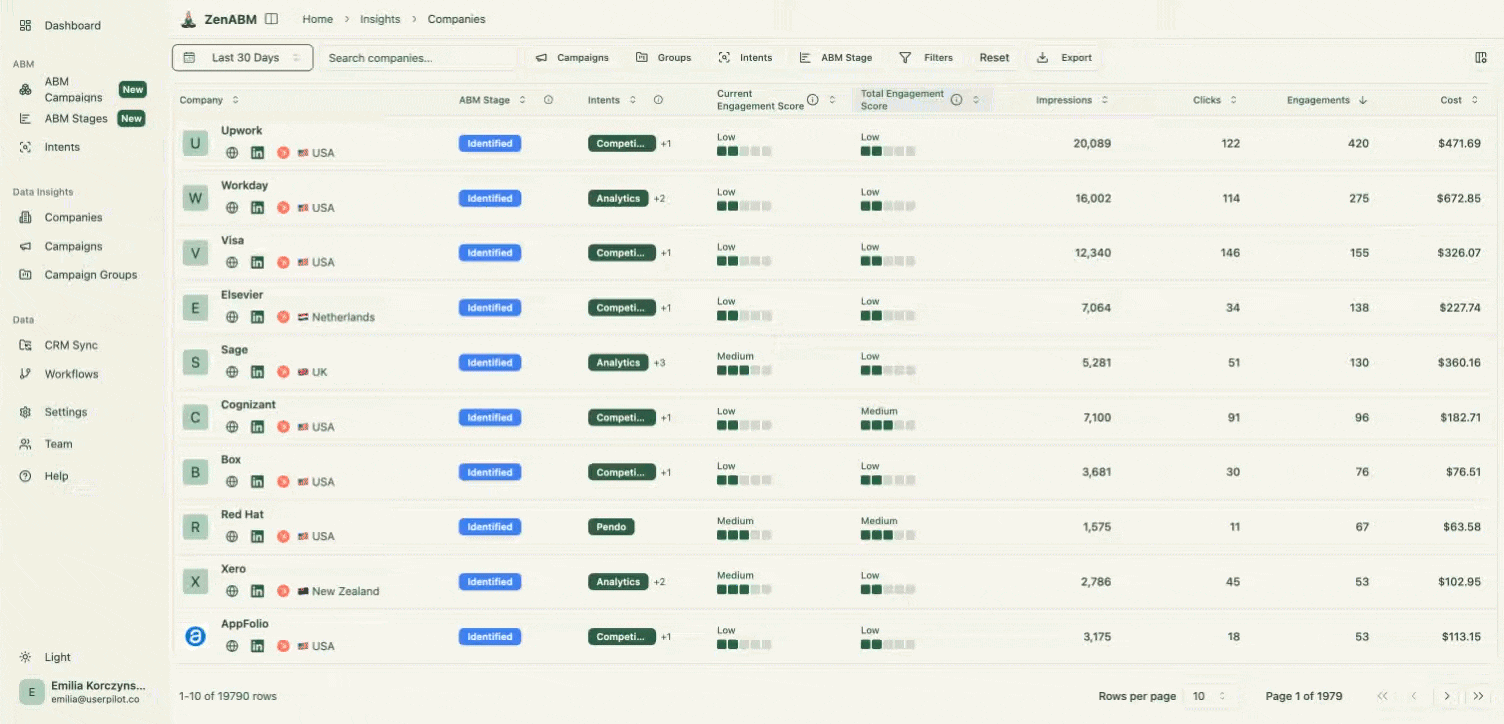
Is ABM Meant for Your B2B Venture in the First Place?
Assuming that if it’s B2B, it must need ABM, can be fatal for your budget.
Here are some characteristics to look for, and only then set out for ABM:
- Deal sizes justify it: ABM is resource-intensive, so it’s best suited for high-value accounts (typically enterprise or upper mid-market). Focus ABM on accounts where the potential ACV is large enough to more than cover the extra time and spend. “Remember your cost of acquisition…don’t waste ABM efforts on a $10k sale already coming through inbound,” advises Tim Deluca-Smith, a CMO:
- You’ve identified your Ideal Customer Profile: ABM works when you have a clear picture of the companies that get the most value from your product (industry, size, tech stack, pain points, etc.). If your TAM is broad or product-market fit is still evolving, a full ABM program might be premature. Many early-stage B2B companies start ABM once they hit post-PMF scale and need to accelerate their enterprise pipeline, not just for revenue’s sake but for growing from a validated start-up to a scaled business.
- Inbound isn’t enough: As seen with Userpilot, SEO and broad inbound tactics can plateau or bring in leads too small/low-fit once your product targets more complex use cases. ABM lets you proactively go after best-fit accounts rather than waiting for them to stumble on your site. It also complements demand gen – in fact, 87% of companies say the best results come from mixing ABM with traditional marketing, using general campaigns as “air cover” for ABM targets.
- Sales and marketing need alignment: ABM is essentially the best way to break the silos your sales and marketing departmements have drifted into.
You see how a ‘huge budget’ is not a prerequisite to go for ABM?
This is because sometimes SEO and media spend can be overwhelming too, and still return diminishing ROI.
But with ABM (disclaimer: rightly done ABM), you can cut down on these costs.
For example, product personalization platform Folloze saw a 43% YoY pipeline increase while cutting paid media spend by 52% after doubling down on ABM.
Foundations of a B2B ABM Strategy: ICP, Segmentation & Team Setup
Before I take you into the thick of it, let’s look at things as basic as identifying your ICP, building TAL, etc.
Ideal Customer Profile (ICP) Definition
ABM success = laser-focused targeting!
An ICP is a profile of the account that is most likely to be a high-value, successful customer.
This goes beyond basic firmographics.
It includes firm size, industry, tech stack, geography, plus specific factors that signal a strong fit or need for your solution.
- Start with your best customers: Analyze your top 5–10 highest-revenue or longest-tenure customers in a segment. What do they have in common? Look at firmographics (e.g. employee count, revenue, funding, region, tech tools used) and also the problems they solved with your product.
- Identify negative factors: It’s equally important to know what excludes an account from being a good fit. For instance, if you sell an analytics SaaS, a company with no data team or one that just had massive layoffs might be a bad fit, even if they meet other criteria. List red flags (e.g. recent competitor contract, incompatible tech stack, etc.) and heed that list.
- Map out the buying committee: In B2B, you sell to a committee, not a single lead. Define the typical stakeholders in your deal cycles (champion, decision-maker, influencers, blockers). For example, a champion might be a mid-level manager who initiates product research, while a blocker could be an incumbent agency or an IT lead worried about integration. Knowing the roles helps you write account-specific messaging later.
- Use intent and engagement data: If available, tap into intent data (from tools like G2, Bombora, etc.) or your own product and content engagement data to refine your ICP. Accounts surging on relevant intent topics or frequently visiting your pricing and case study pages are strong candidates. You can also gauge intent using intent-speciifc ads and then tracking campaign-level engageemnt metrics with tools like ZenABM (more on this later in the article).
In ABM, your list is your strategy and a good list requires meticulous ICP research.
In fact, founders like Dmitri suggest that ICP research for building a TAL doesn’t just help with the list itself but can also transform your entire GTM strategy:
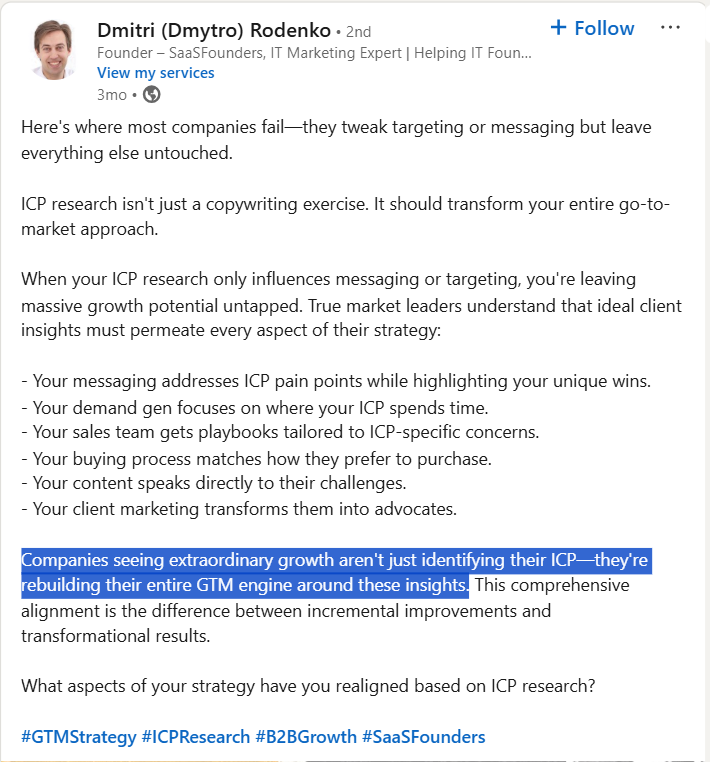
A Real Example: How They Built the Target Account List (TAL) for a Pilot ABM Campaign at Userpilot
For their debut ABM push, the team reused the cold-outbound list from H1. They filtered growth & enterprise “loss” accounts by firmographics (size, region, etc.) and removed any customers that had already converted.
The follow-up campaign targeted companies running a specific technology stack (Clay + BuiltWith APIs helped with the enrichment):
They also considered accounts lost to competitors:
Account Segmentation and ACV Tiers
Not all target accounts are equal.
Segmenting your target account list into tiers ensures you allocate effort and budget appropriately (like you won’t want to make a 1:1 strategy for a low-value prospect, right?).
Here’s a breakdown to help you with the segmentation:
| Tier | Description | Approach | Typical ACV Contribution |
|---|---|---|---|
| Tier 1 | Your highest-value accounts – typically large enterprises or strategic logos with ACV potential at the top of your range. These accounts get the white-glove, one-to-one ABM treatment, including deep research, highly personalized content, and dedicated pursuit plans. | 1:1 ABM (highly personalized campaigns and content tailored individually per account) | >10–15% of segment revenue each |
| Tier 2 | Medium-value accounts that are great fits but not enterprise-level. They typically receive personalized campaigns tailored by industry or use-case rather than fully account-specific. Often termed “ABM Lite” or “Industry-Based Marketing,” these campaigns focus on common challenges within a specific segment or role. | 1:Few or 1:Cluster ABM (industry-specific or role-based campaigns) | Moderate ACV (~4–10% of segment revenue each) |
| Tier 3 | Lower-value or emerging accounts within your ICP that don’t justify heavy ABM investment. These accounts typically receive scaled marketing tactics (demand generation, inbound funnels) with minimal personalization. Individual outreach occurs mainly if strong intent signals appear. | 1:Many ABM / Scaled Marketing (automation and standard nurturing) | Low ACV (usually below the threshold for heavy ABM investment) |
Pro Tip: Periodically review tier definitions. As your SaaS pricing or market evolves, the line between Tiers 1 and 2 may shift. Stay flexible. Move accounts between tiers based on engagement. For instance, elevate a Tier 3 account to Tier 2 if it shows sudden intent (e.g., visiting your demo page 10 times).
Aligning Team and Stakeholders
An ABM program touches multiple functions like marketing, sales, ops, content, and often leadership.
Setting up the right team and alignment structure is critical before campaign execution.
Please consider these pointers:
Form a Core ABM Team
Start with a marketing lead and a sales lead to pick accounts and coordinate outreach. Initially, one marketer and one SDR are enough. As you grow, add roles like content marketers, data analysts, and designers. Focus on tasks, not job titles.
Secure Executive Buy-In
Get support from leaders (CMO or VP Sales) for ABM budgets and goals. For example, Userpilot’s CEO actively encouraged marketing to adopt ABM.
Shared Goals & KPIs
Agree on shared ABM goals, like engaging specific accounts and generating pipeline. Track metrics like Marketing Qualified Accounts (MQAs), pipeline created, and win rate. Set regular reviews to track progress.
Define Roles in The Playbook
Clearly define marketing and sales responsibilities at each stage. Marketing handles early-stage awareness; sales takes over once accounts show engagement (e.g., 5+ ad clicks).
Train and Brief The Team
Educate your team on ABM strategy, target accounts, and custom content. Hold kickoff meetings to clarify workflows between sales and marketing.
End-to-End ABM Framework: From Planning to Execution
With the foundation done, let’s hop into the thick of it:
Setting ABM Goals, Budget, and KPIs
Here’s a list of concrete goals most ABM teams aspire to achieve:
- Net-new revenue (new customer acquisition): Acquire new customers from target accounts.
- Pipeline acceleration: Speed up stalled or slow opportunities with targeted ABM campaigns to re-engage buyers.
- Account expansion: Use ABM to upsell or cross-sell existing customers by addressing specific needs.
- Brand awareness: Build credibility within new segments or markets by targeting strategic accounts for engagement rather than immediate sales.
Tie your goals to specific KPIs. For net-new revenue, pipeline created and deals closed-won are obvious metrics. If pipeline acceleration is a goal, measure sales cycle length or win rate for ABM-touched deals versus others.
For awareness, track engagement indicators like meeting acceptance, event attendance, or content consumption in target accounts.
Set target numbers for these KPIs so you can gauge success (We’ll discuss detailed ABM metrics in a later section).
Budgeting: For budgeting, it’s going to be two main expenditures – tools and ad spend.
The tool stack that we recommend will be discussed later in the article. For ad spend budget, we made a free ABM Budget Calculator:
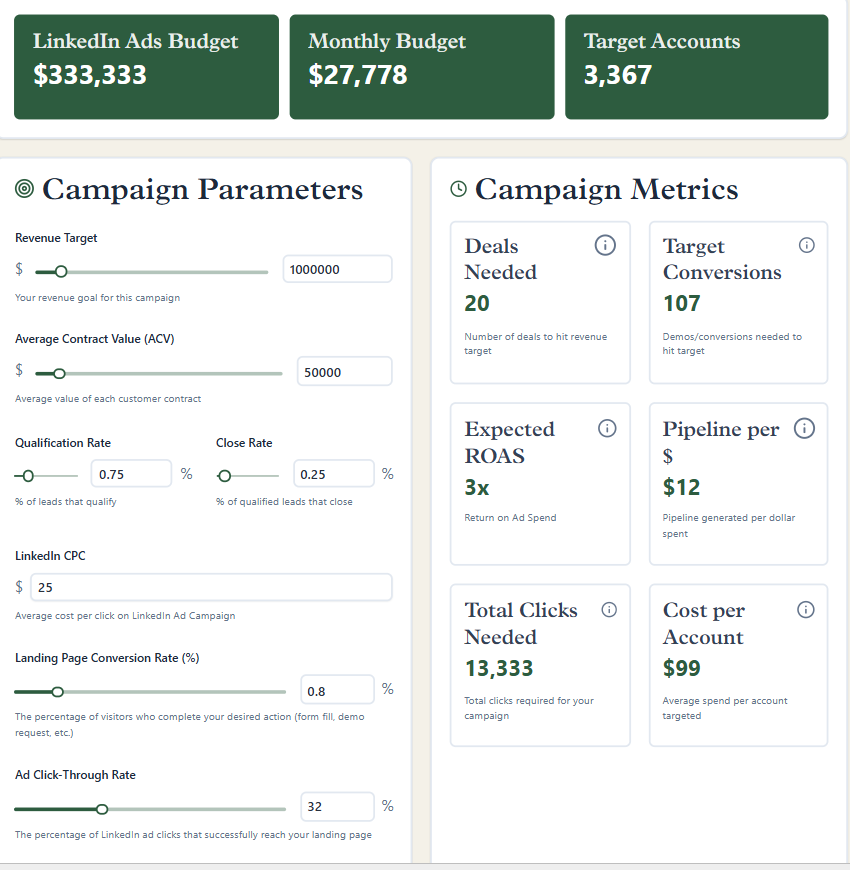
Selecting Target Accounts and Building Lists
Account selection is make-or-break for ABM. A brilliant campaign to the wrong accounts will still fail.
So heed these points:
Embrace Quality Over Quantity
Pick fewer, high-intent accounts rather than hundreds. Prioritize accounts showing internal signals (content engagement, prior sales interactions) or external signals (funding events, hiring relevant roles).
Data Sources to Use
- Intent data: Companies visiting key pages (pricing, demo forms) or showing intent signals (tools: ZenABM, Leadfeeder, Clearbit, 6sense, Demandbase).
- Marketing engagement: Companies with multiple contacts attending events or engaging regularly.
- Referrals/networks: Sales and exec personal relationships or prior conference contacts.
- Past pipeline: Revivable near-miss deals or expansion opportunities with current customers.
Account Research
Remember the tiering we talked about in a previous section? Do that too 🙂
Then, create a brief dossier for Tier 1 & 2 accounts with company info, recent news, tech stack, and key contacts/personas.
Finally, iterate your target list. ABM is not static. Double down on the responsive accounts and instantly stop wasting budget on the dormant ones, suggests Clint Buechler.
Crafting Personalized Value Propositions & Content
With target accounts and personas defined, determine what message and content will resonate with each. This is where ABM truly departs from generic marketing. You need to show each account (or cluster of accounts) that you deeply understand their challenges and can solve them – ideally in a way that competitors or others cannot.
Key steps for personalization:
- Map pain points to your solution: For each account (Tier 1) or each segment (Tier 2), outline the likely challenges they face that your product addresses. Then craft a value proposition that speaks directly to that. For example, Certn realized their HR buyers weren’t obsessing over “background check software features” – their bigger concern was candidate experience and compliance in hiring. So instead of touting product features, Certn’s ABM messaging focused on “how screening fits into a better hiring experience.”
- Use content as a value-add: A smart ABM strategy is to lead with education and insights, not sales pitches. This attracts your target buyers’ attention by offering help, not asking for a meeting outright.
- Account-specific touches: For Tier 1 accounts, go as far as needed with personalization. This can include things like: custom demo portals or mock-ups using the target’s branding, a mini “audit” of their current strategy with recommendations (highlighting where your product helps), or even personalized video messages from your execs to theirs.
- Utilize thought leaders and SMEs: Buyer personas respond well to peers and experts. Incorporate quotes or content from industry thought leaders in your messaging. If you have subject-matter experts internally, put them front and center. (In ABM, your people are part of the content.)
- Multi-channel content mix: Decide which content formats and channels will be used at each stage of your ABM funnel. You can go for different ad formats, and channels like email, social media, etc.
Pro Tip: Personalization is key, but scale wisely. Use templates that you can slightly tweak for each account or persona. Like for LinkedIn Ads, Userpilot dynamically inserted industry names into ad copy for relevance. For one-to-one email, their BDRs used intent data from ZenABM to personalize outreach – e.g. if ZenABM showed an account heavily engaged with a “VS. Competitor” campaign, the rep’s email would directly address how they stack up to that competitor (because they knew that was the prospect’s interest!).
This is ZenABM’s intent tagging feature – it pushes which campaign topics an account engaged with straight into the CRM as company property, so sales can message accordingly:

Executing ABM Campaigns: Channel Tactics, Timeline, and Campaign Structure
With the messaging and content ready, it’s time to finally take off!
For execution, consider these pointers:
Choose Your Channels Wisely
Go where your target buyers actually pay attention. LinkedIn is a common ABM channel (especially for one-to-many plays) due to its targeting capabilities – Userpilot ran their entire pilot on LinkedIn ads and outreach.
1:Many, 1:Few, 1:1 Plays
Structure campaigns according to your tier strategy. For Tier 3 or broad Tier 2, you might start with a one-to-many programmatic approach – e.g. a LinkedIn campaign that targets 300 companies with an industry-specific ebook (note: LinkedIn requires ~300+ audience size to run ads). From those, identify which accounts engage, then graduate them to more personalized 1:Few or 1:1 treatments. This was Userpilot’s strategy: they launched a 1:many LinkedIn ad campaign to dozens of target accounts to see who would bite, then funneled the engaged ones into more targeted sequences and BDR outreach.
Stage-Wise Orchestration
Borrowing concepts from funnel stages or lead nurturing, many ABM teams define account stages (or “journey stages”) and align content to each stage. For example, Userpilot’s ABM stages were: Identified (all targets) → Aware (accounts with 50+ ad impressions) → Engaged (accounts with multiple ad clicks or content downloads) → Considering (account booked a demo or trial) → Selecting (open opportunity).
At each stage, they served different content: early-stage accounts saw awareness ads (high-level pain points, value prop), mid-stage saw interest content (more solution/educational materials), and later-stage saw consideration content (product demos, case studies).
Example of ads by stage:
And for tracking each account’s stage, you’ll need a tool to pull company-level impressions per campaign. ZenABM does exactly that:

Plus, for added convenience, ZenABM pushes LinkedIn ad engagement data into HubSpot company properties:
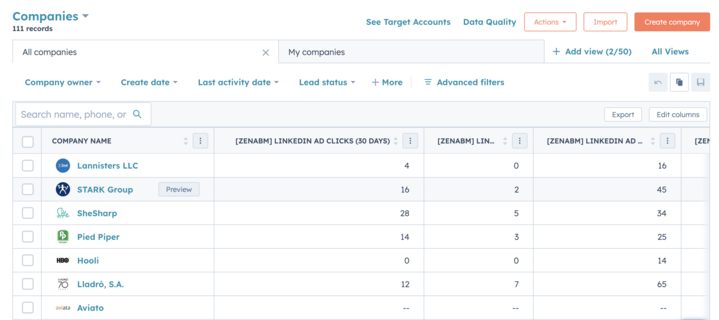
Moreover, it automatically assigns a BDR to an account in your CRM as soon as it reaches the ‘Interested’ stage: 
Timeline and Cadence
ABM campaigns typically run in “cycles” or sprints. A common approach is a quarterly ABM cycle – pick a set of target accounts and run a coordinated campaign over ~90 days, then refresh. Not every account will convert in one cycle; ABM often requires multiple touches over a longer period (6-12 months for big enterprises). But breaking it into cycles helps with planning and learning.
Project Manage The Assets
One underestimated execution challenge is simply managing all the content pieces and tasks. Each campaign may involve dozens of ads, emails, landing pages, and so on, multiplied by the many segments you personalize for. To avoid chaos, use a project management tool (even a simple Kanban or spreadsheet) to track asset creation and deployment.
The Userpilot marketing team, being heavy Notion users, set up a Notion database to organize every ad and content asset needed for their ABM campaigns:
Free Resource: Here’s an ABM template to help you set up an ABM campaign structure and manage ad assets.
B2B ABM Campaign Structure
Now, let’s get into the thick of it and draw how the ABM campaign/campaigns should look.
Userpilot, again, gives great inspiration for this:
Before they created a single ad or landing page, the Userpilot peeps had to decide how to map content to their ABM campaign stages and LinkedIn’s ad setup.
In their first push—“Product Drive 2024”—they targeted 1,417 accounts that hadn’t converted during H1’s cold outbound.
Then, they split them into eight personas and launched separate LinkedIn campaigns, each with messaging matched to that persona’s JTBD.
So, the ABM campaign consisted of campaign groups based on these personas:
The groups further consisted of individual ad campaigns, which were DM ads, video ads, image ads, etc. and were different for each stage:
With ZenABM helping them with company-level engagement per campaign:

They planned to pinpoint intent at the account-plus-persona level and trigger BDR outreach with surgical precision.
The catch?
Three LinkedIn API constraints hit fast:
- Data is hidden if fewer than three members in an account, or fewer than three total engagements occur in a timeframe.
- Each LinkedIn campaign supports only one asset type, so eight personas × two asset types became campaign sprawl.
- At later funnel stages, some persona lists fell below the 300-member targeting minimum.
At this point, they pivoted to an intent-first structure:
- Built campaign groups around shared intent (e.g.,
Cost-Savings,Vs Competitor) instead of persona. - Nested single-asset campaigns under those groups.
- Included multiple personas in each group, excluding irrelevant ones, to stay above LinkedIn’s 300-member threshold.
Why this worked:
- Engagements aggregate at the campaign-group level, surpassing the 3-engagement API threshold, so ZenABM captures full data.
- Grouping single-asset campaigns under one intent bucket restores clarity.
- Multiple personas per group ensure enough contacts for targeting even in late-stage cohorts.
So, finally, the new ABM campaign structure looked like this:
It was a shift from persona-first campaign structure to intent-first (intent here means the specific feature/service being advertised by the specific ad) approach.
So, the ABM campaign now consisted of three campaign groups based on intent (i.e. session replay, analytics and all-in-one). The groups further consisted of individual ad campaigns, which were DM ads, video ads, image ads, etc., and were again different for each stage.
Measuring B2B ABM Success: Metrics, Pipeline Impact & Reporting
B2B ABM Tech Stack Considerations
We saw all the steps of a solid ABM strategy.
Here’s an example of a tool-stack you can use for your B2B ABM strategy:
| Need / Category | Tool(s) | Why It Matters |
|---|---|---|
| Core CRM & Automation | HubSpot CRM + HubSpot Marketing Hub | Logs every touch; central hub for marketing + sales alignment. |
| Sales Outreach | SalesLoft · Apollo | Sequenced email / call cadences for engaged accounts. |
| List Building & Tech Signals | Clay · BuiltWith APIs | Enrich domains, identify tech stacks, and pull intent-like triggers. |
| Project Management | Notion | Tracks asset production, launch dates, and campaign tasks. |
| ABM Analytics & First-Party Intent | ZenABM |
|
Measuring ABM Success: Metrics, Pipeline Impact & Reporting
Unlike traditional marketing, which often focuses on lead volume, ABM prioritizes quality engagement and revenue outcomes. That means tracking performance carefully—monthly or quarterly—matters a lot.
Focus on Engagement and Pipeline Metrics

Source
Skip the vanity metrics. Instead, track:
- % of target accounts that engaged
- Meetings booked per account
- Pipeline from target accounts
- Revenue generated
Even if you only engage a few accounts, if they bring in big deals, it’s a win. Make sure leadership sees how ABM influenced key accounts, not just MQL volume.
Account Progress Through Stages
Userpilot tracked ABM stages like Identified → Aware → Interested → Consideration → Selecting, with clear engagement thresholds.
They also measured stage-by-stage conversion. For instance, “50% of the 300 identified accounts became Aware, 15% got Interested, and 5% reached Consideration.”
If lots of accounts stop at one stage, it might mean your ads or content need improvement.
They built custom HubSpot dashboards to monitor these flows in real time:
Luckily, ZenABM tracks this automatically:

And shows weekly movement through each funnel stage:
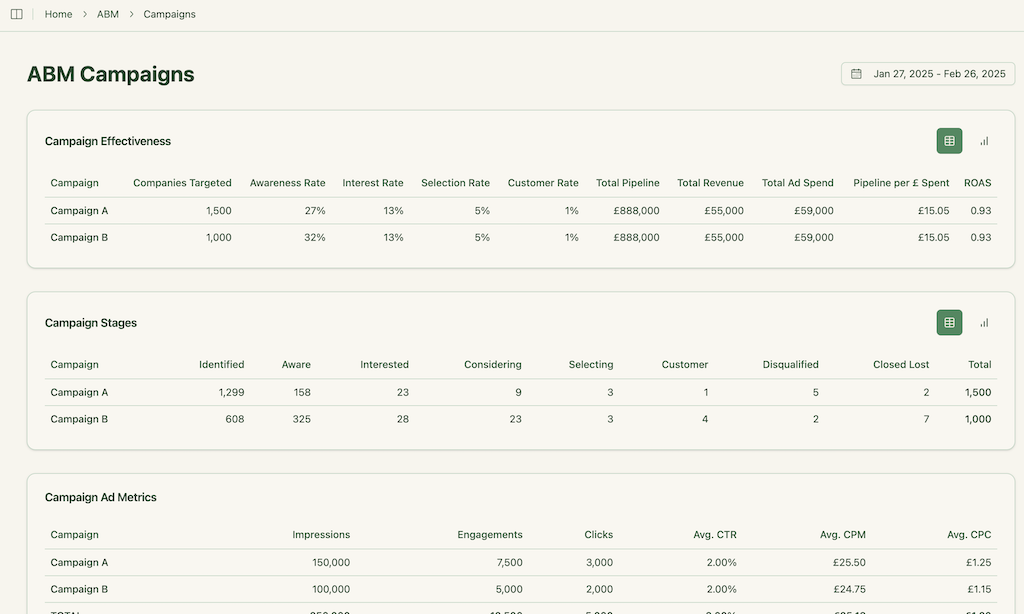
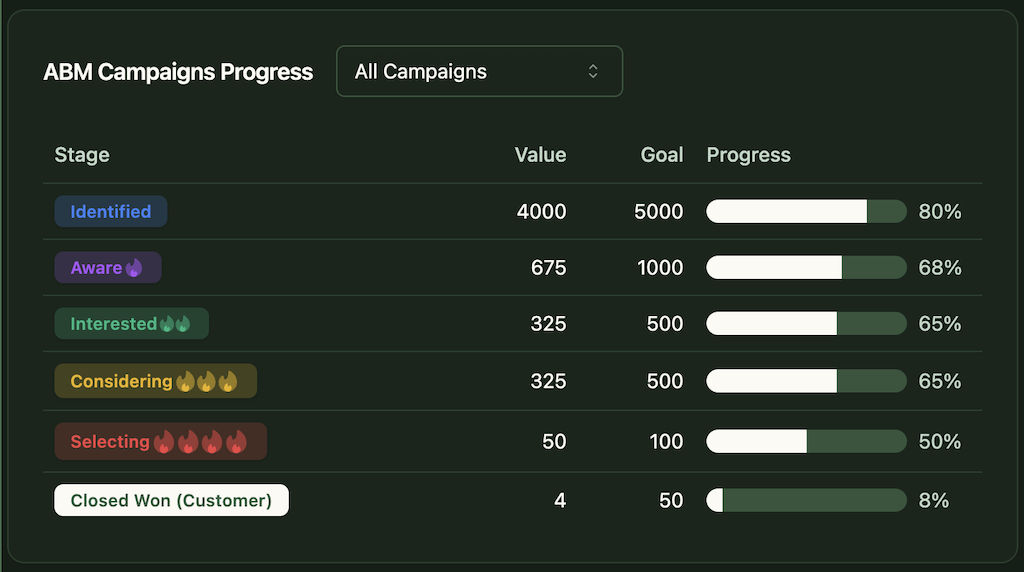
Pipeline and ROI Attribution
At the end of the day, ABM should lead to revenue.
Here’s what Userpilot’s campaign achieved:
- Accounts Targeted: 1,417
- Total Spend: ~$52K (ads + tools)
- Pipeline Generated: $440K+ ($655K in 3 months)
- Pipeline ROI: $8.43 per $1 spent (up to $12 avg.)
- Assets: ~100 ads for 8 personas
- Image Ads: 1,172 clicks, 0.35% CTR, $19 CPC
- Video Ads: 313 clicks, 0.28% CTR, $24 CPC
- Text/Carousel (TLAs): 4.42% CTR, $68 CPC
- Team: 4.5 FTEs across marketing, ops, design, and demand gen
ABM outperformed cold outbound, and it was twice as fast a pipeline and 51% lower cost per opportunity.
But you can’t attribute success without knowing what worked. Because LinkedIn is more about visibility than clicks, view-through attribution is key.
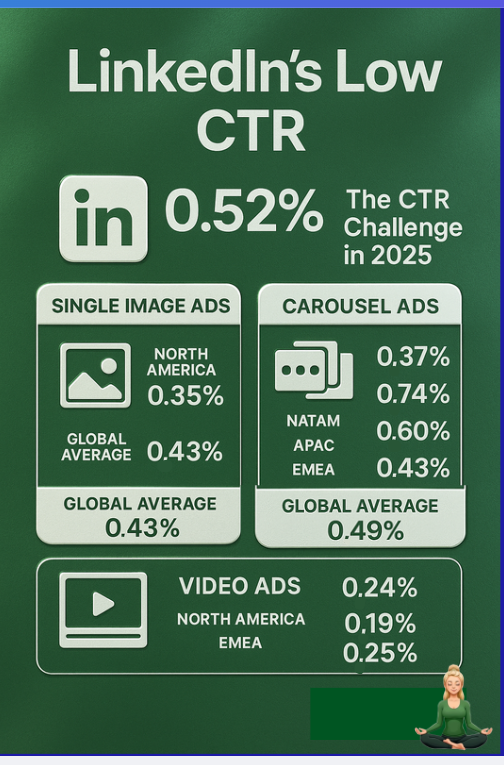
LinkedIn’s CTR is low—making view-based attribution essential for tracking ABM ad impact.
So, How Did Userpilot Attribute ABM ROI?
They synced LinkedIn ad engagement with HubSpot using ZenABM.
ZenABM pulled account-level metrics directly from LinkedIn’s API:

And pushed that data into HubSpot as company fields:

LinkedIn ad data synced into HubSpot’s account records via ZenABM
It also mapped ad-engaged companies to deals in CRM, showing direct revenue impact:
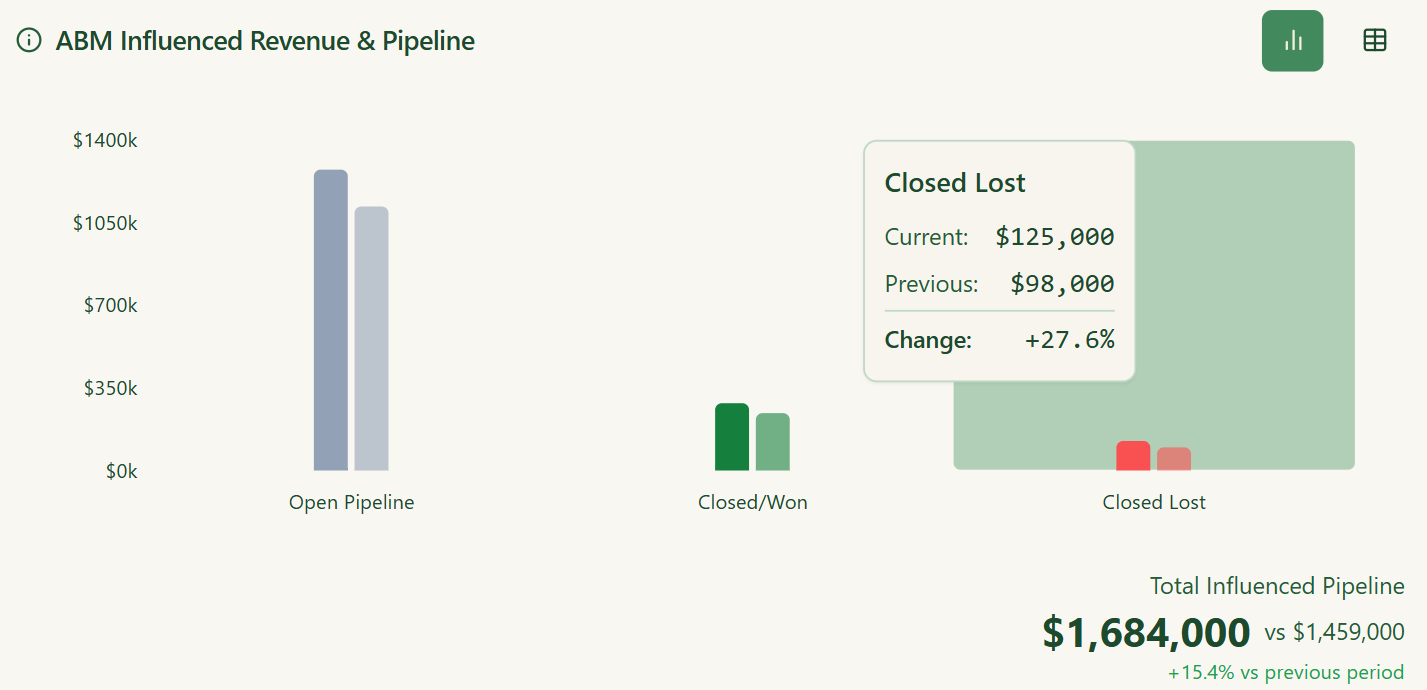
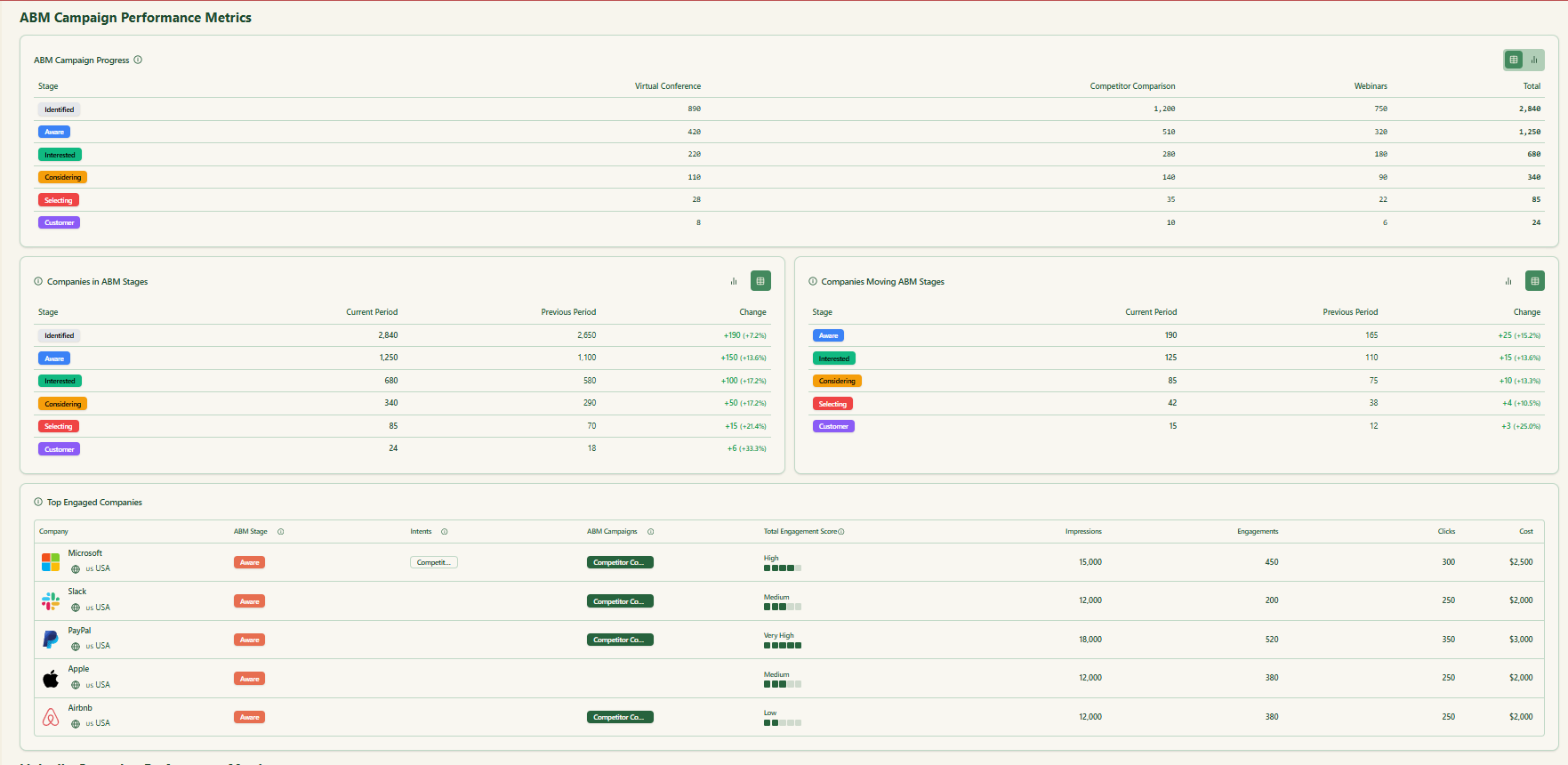


Learn and Iterate
Finally, use these insights to improve. Identify which content or campaign drove real results, then double down.
Compare, for example, if “Competitor X” campaigns outperformed “Thought Leadership Y.”
Also, collect feedback from sales: what helped close deals fastest? What content drove better conversations?
ABM is never static. It’s a cycle of testing, learning, and evolving.
End Note
I hope you found the B2B ABM strategy guide helpful.
You can contact me (the content guy at ZenABM) or Emilia Korczynska (VP of Marketing at Userpilot) herself for more info regarding their B2B ABM strategy that, bragging again, bagged more than $900,000 in pipeline with a $52K investment (LinkedIn ad spend + Tools).
Plus, you can try ZenABM now for free!

